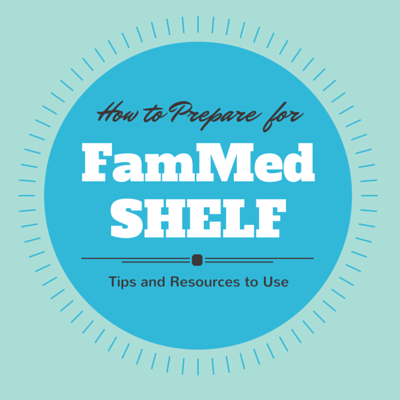How To Prepare for your COMAT / Shelf Exams
COMAT / Shelf Exams
If you’re reading this, welcome to third year: a magical time that will make you remember why you applied to med school in the first place. The most important thing to remember about third year is that you are awesome. You survived the first two years of school and finally made it to rotations, so give yourself a pat on the back.
This article is focused on the COMAT or shelf exams you take at the end of each rotation. COMATS are the DO version of shelf exams, graded with an average of 100, and visually show how you did in each sub-topic in the score report. NBOME says a score below 93 is poor, a score between 93 and 107 is average, and a score above 107 is good or above average. This may change, so be sure to check before you take your COMAT. My school provided a scale, so if I got a 112 on a COMAT, I would get a 93% for my rotation grade. You’ve been taking tests for so long you think they are the most important. But you need to remember your number one priority is keeping your preceptors happy. It is great to do well on the exam, and it helps prepare you for COMLEX Level Two, but the main part of your grade is usually from your preceptors. COMAT scores were only 30% of my rotation grade.
I did really well on all of the COMATS, so I am going to go over how I prepared for each of them.
Family Med:
First, I went through the NBOME’s outline for that COMAT and made sure I had an idea of what kinds of cases would be presented. Then I used Lange Family Med Case Files. This was my first rotation and I was really worried about it, so I read through the book about three times during the eight week rotation. I also did readings from the Washington Manual and Harrison’s Internal Med, but I don’t think those helped as much as the Case Files book.
I also did some practice questions. I used the COMBANK COMLEX question bank, as the COMAT prep series my school purchased was not available yet. In addition, I had a wonderful preceptor who challenged me to think and develop a differential diagnosis for cases. This COMAT was one of my highest grades for the year.
The exam was a mix of everything, but so is family med. There was a large amount of OB on the exam, but nothing came as much of a surprise.
OPP:
I found this exam a bit more challenging. My school schedules it at the end of the first internal med rotation. It was an outpatient rotation, so I did get a bit of OMT experience in, but not a whole lot, and exams are easier when they actually apply to what you’ve been doing all month. I used the “Green Book” by Savarese that all DO students should already have. I wish I had done more practice questions, but we still didn’t have the COMAT prep questions from COMBANK available. The exam still went fine. The questions are like any other NBOME OPP style question. They don’t really make much sense. Get out your scrap paper, work through each question, and you’ll be fine. Remember your spinal sympathetic levels, you still need those after COMLEX Level One.
OB/GYN:
I used Blueprints OB/GYN for this exam. The rotation was pretty intense with long hours; I found that if I brought the book with me I’d have down time to read, and also read each weekend. I got through the whole book in the first three weeks, and then I did all of the COMBANK COMAT questions for OB/GYN. I found the questions pretty helpful. Many of them were similar to the questions that showed up on the COMAT. I thought the exam was a good mix of everything with basic OB, although my friend seems to remember a lot of PCOS questions. My preceptor worked to really prepare me for the exam, and was always asking me questions, so I did a lot of reading every day.
Psych:
I used First Aid for the Psychiatry Clerkship. the DIT primer video questions and COMBANK COMAT questions too. for this rotation. In addition, my preceptor and his colleagues offered wonderful lectures on different topics throughout the rotation. My rotation was a great mix of inpatient and outpatient experience, so I felt more than ready for the COMAT.
I would worry about getting the diagnosis. Time frames are important for a lot of the diseases, so learn those. I seem to remember a lot of psychpharm on the COMAT. Those drugs can be hard because the names don’t really help you group them into classes. And remember the most important thing is to rule out a general medical condition – just because it is a psych exam, don’t forget that hypothyroidism can cause depression.
Internal Med:
I went back to using Case Files for Internal Med for this one. I had way too much free time on this rotation, so I also read UpToDate a lot and used Pocket Medicine to research individual cases. I did the COMBANK COMAT questions all within the first week, so I didn’t find them very helpful. We had lectures put on by residents at lunch everyday, and afternoon didactics sessions on Friday. I remember this exam being similar to the family med exam, so the whole thing went pretty well.
Pediatrics:
I used Case Files for Pediatrics, the COMAT COMBANK pediatrics questions, and parts of First Aid for USMLE Step 2. If I were to do this one again, I would focus more on developmental milestones and vaccine schedules; Case Files didn’t really emphasize that, but it was important for the exam. Luckily, my preceptor drilled those into us. If you aren’t in a hospital setting, remember you are missing out on the newborn stuff, and the really sick kids. It’s not too hard, just make sure you review it before your exam! More important than the schedule, make sure you know the number of vaccines and special circumstances. For example, how many Tdap vaccines do you give? And what vaccines do you give to an asplenic child? Vaccine schedules change regularly, but the number of vaccines usually doesn’t.
Surgery:
This was my last rotation for the year. My preceptors were wonderful, but they didn’t have a huge variety of cases. They did try to lecture and quiz me on other cases though, and gave me topics to read on a nightly basis. I used the COMAT COMBANK questions, and found them pretty similar to the test questions. I really liked Dr. Pestana’s Surgery notes a lot, it is short and to the point; he goes over everything and it kind of seems like he’s talking to you. Make sure you brush up on anatomy for this one. I also used First Aid and drew out some anatomy. I did the liver/gallbladder, colon blood supply, and breast anatomy. Made it all colorful with my wonderful pens. This COMAT was one of my best scores, and a lot of people have said it is one of the harder exams, so I think my preparation worked.
Well. That’s all of them. All in all, I really liked the Case Files books. They are easy to read and often cover the major things you need to know. And the style is really great for reading between patients. The questions at the end of each case help you to make sure that you got the important things out of the reading. And of course, if your preceptor recommends a book, you should probably get it. They know what they’re doing.
- UPDATE 2/8/2016: COMQUEST recently released brand new COMAT question banks.Read Pixie’s review of COMQUEST’s COMAT qBanks now
- UPDATE 2/25/2016: You can check out Farrah’s perspective on COMQUEST’s new COMAT qBanks, too.






Pingback: How Do I Study for the Family Med Shelf? - FM Student
Pingback: Our Favorite Posts: A Taste of FMstudent.com - FMStudent.com